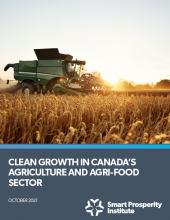Canada is well-positioned to substantially grow its agriculture and agri-food sector in the coming years; however, the sector’s significant environmental footprint needs to be addressed if Canada wants to simultaneously meet its commitments to reduce greenhouse gas emissions, conserve biodiversity, and sustainably manage Canada’s natural capital.
Canada is the world’s 5th largest agricultural exporter, but our agriculture sector contributes about 10% of our country’s total GHG emissions. Canada has the opportunity to leverage its position as a trusted global leader in supplying safe, nutritious food to diversify its export markets, but global market access is increasingly based on a country’s ability to uphold strict environmental and safety standards. Decoupling economic growth from environmental harm requires action through a well-targeted and comprehensive package of policies for the agriculture sector.
To unlock clean growth opportunities in Canada’s agriculture and agri-food sector, Smart Prosperity Institute’s research has identified nitrogen fertilizer management, improving soil health, reducing emissions from the beef and dairy sector, and circular economy approaches to agriculture and agri-food as some of the key areas for fostering clean growth. This report also explores a series of promising policy options that can motivate the adoption of environmentally beneficial management practices and increase clean technology deployment across Canada’s agriculture and agri-food sector. These include:
- Behavioral Economics Approaches
- Taxes on Environmental Externalities
- Voluntary Ecological Certification
- Targeted Agri-environmental Subsidies
- Reverse Auctions
- Spatially Targeted Payment Schemes
- Offsets for Greenhouse Gas Emissions, Water Quality, and Biodiversity
READ THE REPORT
Key Messages:
1. Canada’s agriculture and agri-food sector is on the cusp of an extraordinary economic growth opportunity. Demand for high-value food (e.g. proteins and functional foods) is expected to increase significantly in the coming decades, as a result of population growth and an increase in the size and purchasing power of the global middle class.
2. In recognition of this opportunity, the Economic Sector Strategy Table for Agri-Food adopted an ambitious target of $85 billion in agriculture, agri-food, and seafood exports and $140 billion in domestic sales by 2025. As the world’s 5th largest agricultural exporter, Canada has the opportunity to leverage its position as a trusted global leader in supplying safe, nutritious food to diversify its exports markets.
3. Meeting these targets and satisfying the growing global demand for food in a sustainable manner should be a top priority for Canada. In 2019, agriculture (including on-farm fuel use) accounted for 73 Mt of greenhouse gas (GHG) emissions, equal to 10% of the country’s total GHG emissions. In addition, soil carbon sequestration rates, water quality indicators, and the suitability of farmland for wildlife habitat have been in decline.
4. Canada has already taken the first steps toward reducing the environmental impact of the agriculture sector. The federal government has committed to reducing its GHG emissions by 40-45% below 2005 levels by 2030, and as part of these commitments, has set a national target to reduce GHG emissions from nitrogen fertilizers by 30% below 2020 levels by 2030. In addition, leaders in the agri-food industry have started to adopt sustainable sourcing commitments throughout their supply chains.
5. Reconciling the economic opportunity with the environmental challenge will be no small feat and no single instrument or practice will be sufficient to do the job. For example, the adoption and use of beneficial management practices or clean technologies is pivotal to reducing the environmental impact of the agriculture sector; however, there are several concerns facing Canada’s Federal-Provincial-Territorial cost-share programs — one of the main vehicles for promoting the adoption of environmentally friendly management practices. These concerns include:
- Selection biases that result in environmentally motivated farmers being more likely to participate in the cost-share programs, rather than those in greatest need of environmental improvement.
- The tendency for producers to mostly adopt BMPs that are highly visible, easy to trial, or that primarily provide private economic benefits.
- A paucity of rigorous impact evaluations that assess what environmental and economic outcomes would have been in the absence of the cost-share programs.
6. To unlock clean growth opportunities in Canada’s agriculture and agri-food sector, there are several key areas to focus on. Participants at SPI’s workshop in January 2020 identified nitrogen fertilizer management, improving soil health, and circular economy approaches to agriculture and agri-food as some of the most promising opportunities for clean growth in Canada’s agriculture sector.
7. Decoupling economic growth from environmental harm requires a well-targeted and comprehensive package of policies for the agriculture sector. Some of the most promising policy options moving forward include:
- Behavioral Economics Approaches
- Taxes on Environmental Externalities
- Voluntary Ecological Certification
- Targeted Agri-environmental Subsidies
- Reverse Auctions
- Spatially Targeted Payment Schemes
- Offsets for Greenhouse Gas Emissions, Water Quality, and Biodiversity.
8. Canada is facing an unprecedented opportunity to foster clean growth in the agriculture and agri-food sector, while also contributing to Canada’s environmental objectives. But current approaches are not enough to get us there. Through innovative policy approaches, federal, provincial, and territorial governments can help increase technology deployment and BMP adoption to the benefit of producers, industry, the environment, and all Canadians.



